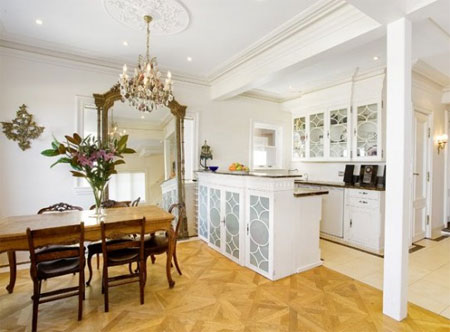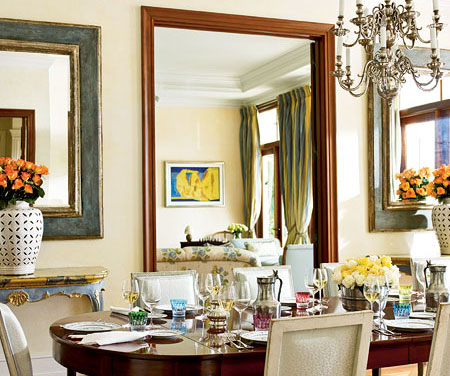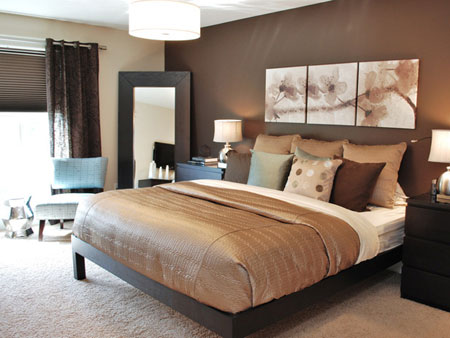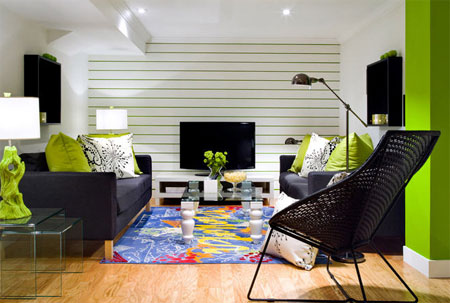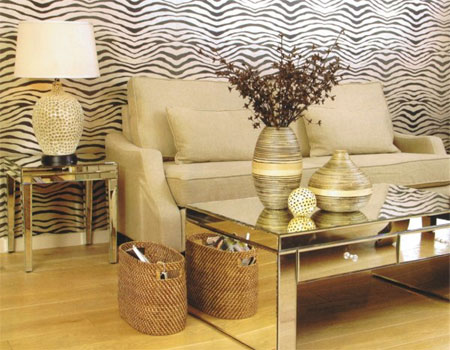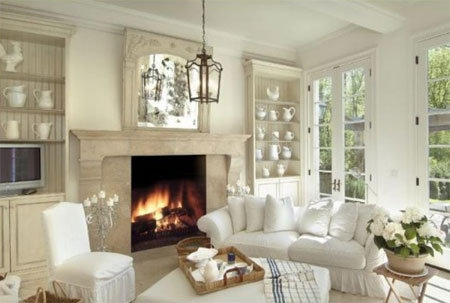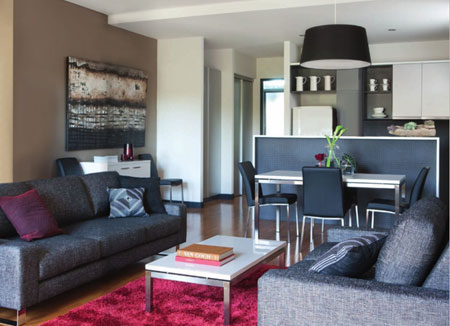Make a room appear larger
In a small space, everything counts! That’s the main idea behind this article, and how to make a small room look bigger - with some clever tricks.
ADD MIRRORS
Mirrors are a decorative item that never gets enough fanfare. They can be used as a finish material on walls, and as a cladding on furniture. Hung over fireplaces and placed in frames, mirrors can transform a room from small to roomy in an instant. Mirrors are extremely versatile in that they can represent any décor style, and can also be used in feng shui to channel energy! Your home can benefit from the use of mirrors, and here are some simple uses.
Place a mirror over the fireplace: For most homes the fireplace is already the focal point of the room in which it resides. Add more emphasis to the fireplace by placing a beautifully framed mirror above the mantel. This will enlarge the room, and add a reflective surface to the décor you place on the mantle. From candle sticks to seasonal décor, a fireplace begs for a gorgeous mirror to adorn it.
Hang on a wall: In small rooms and especially apartments, mirrors offer an inexpensive way to give the illusion of space. Place mirrors on a wall opposite of a window wall and see how the view is multiplied times ten throughout the rest of the space. Use mirrors in a small kitchen as a backsplash and suddenly you will enjoy cooking and spending more time in your kitchen.
Brighten up your entry: Mirrors placed in a foyer or entryway is a welcomed sight for guests. They reflect light and open up a dark entry and give a place for guests to ‘check’ themselves while entering your home. In a larger foyer, place a small table, flower arrangement, lamp and mirror on the wall to expand the living area into this welcomed space. Try adding a mirrored buffet or table to adjacent rooms to make the entry flow into another room seamlessly.
Bedroom full length mirrors can be fun: Full length mirrors can be a simple framed piece on a wall or you can have a bold statement as a piece of furniture. In home décor magazines, mirrors that sit on the floor, and are seven feet tall are a beautiful way to add emphasis to an empty corner of a bedroom. Use multiple frameless mirrors on a wall to give visual interest, as well as a dressing room effect in your room. The possibilities are endless, and bedrooms are all about self expression!
Mirrors reflect light into a space to brighten and enliven the décor. Try using mirrors in varying sizes, and with different colour frames to give this versatile material several aesthetic uses throughout your home. The true beauty of mirrors is that they can be utilised in every room of your house, try these tips and see which room you love mirrors in the best!
FURNITURE THAT FITS
Use multi-function furniture like a chest that can be used as a coffee table, sofa beds, chest of drawers, and beds with drawers for storage etc. Stick to clean lines in the furniture. Use an extendable dining table, folding tables and nest of tables, which can be tucked away when you don’t need them.
Scale the furniture to fit the size of the room and don’t block walking pathways. With furniture and accessories blocking the view into a room and out to open spaces, a room will look cramped. By moving furniture out and away from walkways, you’ll open up the space and make it feel larger. If you can see the floor, the room will look larger. Having oversized sofas or too much furniture will make the living room look smaller.
Consider having at least some of the furniture pieces the same colour as the walls. Even the bigger items like armoires and chest will begin to blend in to the room and widen out the room. You can add some detail by stencilling in a design or accent onto the furniture.
Setting your furniture at an angle works because the longest straight line in any given room is it’s diagonal. When you place your furniture at an angle, it leads the eye along the longer distance, rather than the shorter wall. As an added bonus, you often get some additional storage space behind the piece in the corner, too!
Choose a sofa and chairs with open arms and exposed legs. A glass or mirrored table, will keep the appearance of a open and free space. This allows light to filter under the furniture, making the room appear airier.
LIGHT IT RIGHT
Lighting is a key element in opening up a space. If you have access to natural light, make full use of it. Bring it into your home through windows. Full height glass panes work best. Having a large picture window can make a room seem bigger because a barrier between visitor and outside view has been removed.
Instead of seeing a dimension-defining wall, visitors see an expansive view of the outdoors. Make sure window coverings are sheer, or are pulled back, to bring more light in. If the view is bad use hanging plants and potted flowers near windows. Lamps will bring in colour and focus attention.
Mirrors reflect both natural and artificial light to make a room brighter during the day and night. They bounce light deep into the room, making it appear larger. This is especially effective with near a window so the outdoors can be reflected. Mirrors on the walls and glass tabletops will make it seem like there’s a more open flow. You can also use mirrored cabinet doors to make spaces feel large and uncluttered.
LOSE THE CLUTTER
In kitchens and bathrooms, take advantage of under counter and cabinet organisation tools. Don’t forget items can be hung on the inside of cabinet doors, and drawers organisers will help put everything ‘in its place’. Don’t forget space on top of your cabinets, refrigerator, and back of the bathroom door.
In the bedroom, take advantage of space under the bed, and over doorways. Shelving over doorways for books is a unique and decorative way of adding the illusion of space. Use vertical book shelves to maximise storage and display decorative collectibles.
Keep living spaces tidy and organised. There’s nothing that makes a small space feel cramped more than having too much stuff. With things neatly arranged and out of sight, the space that is in view will feel orderly and open. A cluttered room equals a smaller room.
Don’t cover your walls with a lot of pictures: One large painting works better than a group of small paintings. If there’s too much going on, all clamouring for attention, it can make the room feel busy and crowded.
When decorating a small room, create a focal point, one area or feature that will draw the eye. In the dining room, the focal point will probably be the table. In the bedroom, it’ll probably be the bed. Make that focal point the star of the room. Arrange the furniture so that focus is drawn to that area, and keep the décor in the rest of the room to a minimum ( limit the number of accessories ).
Keep the floor as clear as possible: This is one of the most important ways of maintaining a sense of spaciousness. If you need a rug in the room - limit it to one large rug instead of several smaller ones.
COLOUR IT RIGHT
Use light, neutral colours to give the illusion of space and airiness. Whites, beige’s, greys, and muted pastels can make your small space feel bigger. By tricking the eye, walls will seem to disappear, rather than stand out.
For accent walls, consider colours that are a darker hue of the already used neutral colour. For example beige walls, with a darker taupe accent wall will still help to make the walls blend with one another.
When using darker colours, use them on window walls, or walls with several openings. The darker colour will actually seem lighter, because of the window light and breakup of doorways, entryways, and hallways. Try to place furniture in front of accent walls to also “eat up” some of the dark colour of accent walls. Remember, the lighter the colour the more space that will be felt in the room.

